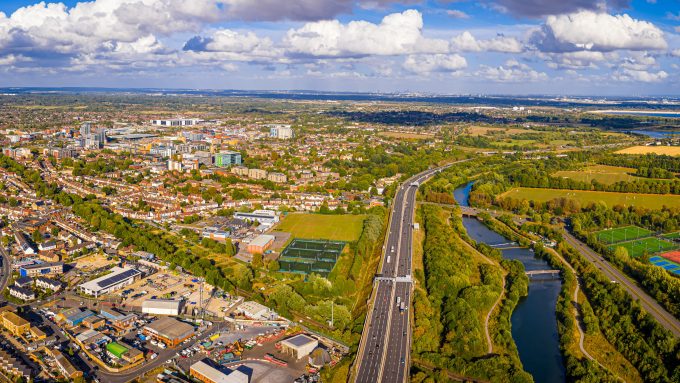
Meet the academic with concrete plans for climate adaptation

“Many engineers have made a significant impact on society, and my ambition is to be one of them,” says Dr Alalea Kia of Imperial College London. “I’ve always wanted to make a difference to people’s lives.”
Alalea is a materials scientist, researcher and engineer who has developed a permeable concrete pavement to quickly remove standing water from footpaths, cycleways and roads, to reduce the impact of flooding.
Her eponymous new material, called Kiacrete, uses less cement in an effort to reduce carbon emissions associated with conventional concrete, and is designed to be durable with a long operational life. The material is about to be trialled on the highway network, and Alalea is discussing future installation opportunities with infrastructure operators.
Alalea currently teaches structural engineering at Imperial, and leads a research group of PhD students and postdoctoral researchers focused on developing resilient and sustainable infrastructure to help urban areas combat the threat of climate change and pressure of urbanisation.
“Our cities are not ready for the impact of climate change, which will involve extreme weather such as snow and ice, heavy rain or high temperatures,” she continues. “We need to come up with new ways of developing infrastructure to help tackle the issue.”Dr Alalea Kia of Imperial College London
An early love of structures
From a fairly young age, Alalea was fascinated by structures like the Golden Gate Bridge and how they remain standing when exposed to wind, “despite being very slender”.
Alalea attended secondary school in south London, enjoyed maths and physics, and went on to study civil engineering at University College London.
Alalea enjoyed the “very hands on” practical aspects of the course and remembers taking part in a ‘scenario week’ in her second year where students worked together to design a footbridge. “I liked the challenge of working with a group on calculations, and to develop a bridge to withstand the loads it would be exposed to.
“Now as an academic, I use a similar approach with my students to design reinforced concrete bridges.”
Alalea received her Masters in engineering from University College London. She then accepted a sustainable civil engineering PhD scholarship offered by the Centres for Doctoral Training from the Engineering and Physical Sciences Research Council, to study towards a PhD in concrete materials at Imperial College London.
“I came across permeable concrete, designed to allow water to drain through, but noticed that it wasn’t widely used,” says Alalea. She discovered that permeable surfaces are highly susceptible to clogging from debris and tended to have low strength. Alalea decided to develop her own permeable concrete pavement to address these challenges.

Inspired by drinking straws
Alalea’s early attempts in the lab to create a permeable concrete involved inserting drinking straws into the material to aid drainage. “It was very difficult to stop the straws from floating, so I needed to come up with a design that could be used in a real-world setting and a concrete material that could flow around the tubes,” she explains.
The trials led her to create a repetitive pattern of circular open channels through a concrete surface to allow drainage.
Kiacrete was first installed at Imperial’s White City campus, and Alalea says it demonstrated excellent long-term drainage and durability performance. “I was very keen to measure the slip and skid resistance of the material at the site, however I did not have access to the appropriate equipment.” Alalea wanted to understand how the surfacing could be used to prevent weather-related accidents and enhance societal safety, compared with traditional pavement surfaces.
Taking the technology further
To understand Kiacrete’s slip and skid resistance properties, Alalea applied to the Transport Research & Innovation Grants programme, delivered by Connected Places Catapult on behalf of the Department for Transport. She also looked to understand how pigmented concrete could be used to produce a range of colours of the material, for use in different applications such as cycle and bus lanes.
Alalea and her research group were able to show that the new surfacing demonstrates improved slip and skid resistance compared with traditional concrete pavements, in both wet and dry weather conditions. “We also gained confidence in using pigments of different concentrations, which has led to new pigmented Kiacrete pavement slabs,” Alalea adds.
Aside from receiving funding, she was grateful for the TRIG programme offering her a chance to be “connected to other people going through the same challenges, and be part of a network”.
The TRIG programme, she added, “helped me to showcase the idea, connect with policy makers and start conversations on new pavement deployments”. Alalea urges those taking part in future rounds of TRIG to “have a really clear plan for what you want to achieve” and to network widley. “It’s very important to start conversations early on, and to talk to as many people as possible.”
Alalea is looking for more trial sites to demonstrate Kiacrete, and hopes to see the material used in the next few years for a range of applications from pedestrian footpaths to cycleways, roads and airport taxiways and aprons.
“It's very important to adopt innovations within the transport sector, which can lead the way for other sectors to follow,” she adds. “If we are more open to innovation, I believe we are more likely to achieve net zero, climate resilience and enhanced safety.”
Alalea encourages other academics and innovators to be confident when developing new ideas, especially if they think they will make a marked difference to society or the environment. “Don’t lose faith, and meet with others in industry as early as possible.
“I'm excited by the continuing research, and love what I do: that’s what keeps me going.”
Find out more about the Transport Research and Innovation Grants programme.





